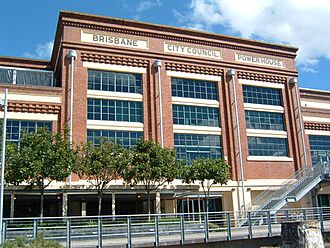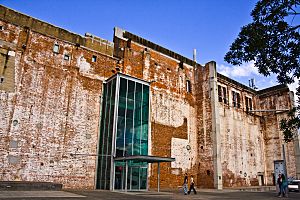Brisbane Powerhouse facts for kids
The Brisbane Powerhouse is a popular center for arts and culture located in a former power station in the Brisbane suburb of New Farm, Australia. Inside this historic building, you can watch live shows, see art displays, visit festivals, and take part in free community events.
The building first opened in 1928 to create electricity for the city's tram system. It stopped being used as a power station in 1971. After many years, it was renovated and reopened in 2000 as the exciting entertainment venue it is today.
Contents
From Power Plant to Arts Hub
The Brisbane Powerhouse sits on the bank of the Brisbane River. It was once known as the New Farm Powerhouse and was designed by architect Roy Rusden Ogg. It was the first power station run by the Brisbane City Council.
Powering the City
The main job of the powerhouse was to supply electricity to Brisbane's entire tram network. It also provided power to suburbs like Yeerongpilly, Toowong, and Ithaca. As Brisbane grew, the powerhouse supplied electricity to even more areas.
In 1963, the City Council sold the building to the Southern Electrical Authority, which was part of the Queensland Government.
The End of an Era
In 1967, Brisbane decided to replace its trams with buses. The last tram ran on April 13, 1969. With no trams to power, the powerhouse was no longer needed. It was officially closed, or decommissioned, in 1971.
For the next 20 years, the empty building was used for different things. It was a storage place for chemicals and a works depot. The Australian Defence Force even used it for training exercises. The building was also used by young people and those without homes, who left behind graffiti art and messages on the walls. In 1989, the Brisbane City Council took ownership of the building again.
A New Design for an Old Building
The Powerhouse is made of three main parts: the boiler house, the switch house, and the turbine room. When the city decided to turn it into an arts center, they hired architect Peter Roy. He wanted to reuse the old building while making it a modern space.
His team made some changes, like removing parts of walls and replacing the old roof. They were careful to keep the building's history alive. They even reused bricks from a damaged wall in other parts of the building. Today, you can still see an old crane and some of the original graffiti, which adds to the building's unique character.
The updated building opened in May 2000. In 2006, it was renovated again to add better facilities, improved performance spaces, and more outdoor areas for visitors to enjoy.
The Powerhouse Today
Today, the Brisbane Powerhouse is a busy arts center. It has two main theaters: the 536-seat Powerhouse Theatre and the 200-seat Visy Theatre. It also has a large open space called the Turbine Hall, an outdoor plaza, a rooftop terrace, a bar, and a restaurant.
The Powerhouse hosts many events, including plays, concerts, and art shows. It also holds workshops for kids and the community. On weekends, you can often find farmers' markets outside the building. It's also a popular place for weddings and other special events.
From 2010 to 2016, the Powerhouse was home to the World Theatre Festival. This event brought performers from all over the world to Brisbane, including groups from the United Kingdom, Germany, the United States, and Australia.
See also





